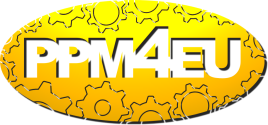


The project idea was the result of several preparatory meetings, most recently in Dublin in December 2018. The main product, a so-called "Penny Press Machine", was the focus of our school partnership. This type of coin press is often found at tourist hot spots. Typically, the customer drops a euro-coin into the printing slot and at the same time a 5-cent piece. By operating a crank, motifs are then imprinted on the surfaces of the copper coin.
The aim of our partnership was for the partners to develop a functioning "Penny Press Machine" as an exhibit in the course of the joint project work. This will be permanently displayed in a central location in the school building where it will receive public attention. Since a total of six partner schools participated in the project, the machine should also be able to mint six different motifs each, so that even after the end of the project, a bond within the framework of the "European CNC Network" is guaranteed. The motifs on the embossing rollers were individually designed. In addition to the specially designed project logo, they also show images which are typical for the region. As a sustainable European cooperation, the project work thus represents both, the commonality and the uniqueness of the member states of a united Europe.
The partnership represented the entire process of product development. It connected the classical methods of CAD engineering to the highly innovative 3D printing technology used for prototyping and industrial manufacturing based on modern CNC machinery. In our project this technology was embedded in the comprehensive digitalization-in-production as described in the ideas and visions of the strategy "Industry 4.0". The production of the "Penny Press Machine" placed high demands on the mechanical engineering production in its complexity. Such tasks are basically found in all technical curricula. The students were between 15 and 20 years old and were supervised by at least two teachers at their school. The partnership was supported by close networking with craft and industrial companies, which were actively involved in the project work.
The partner schools involved had the technical equipment in their modern training workshops. With a view to a successful project work, the participation of each partner school was essential, as every single school brought in individual strengths and unique competences, which complemented each other and only in sum guaranteed a high-quality project result.
Regarding the project outcome from a pedagogical point of view, the "Penny Press Machine" was just a vehicle – a means to an end to shape and create basic skills and key competences. It offered students the chance and challenge to work and cooperate on a technically demanding task in an international atmosphere. The project work focused on action-oriented peer-to-peer learning. Through this approach, the students internalised a subject area more intensively, as they independently developed learning content and deepened it by sharing and discussing what they had worked on with other learners.
Five project meetings were held during the almost three years of the project. The activities followed the phases of the project progress under the strong influence of Covid-19 restrictions. The responsibility for individual project tasks was distributed among the partner schools in work lines and separate work groups. The time between project meetings was used to work on agreed tasks. Students communicated and discussed their solutions regularly using appropriate groupware platforms.
Working together on a technical challenge intensified the international and intercultural dialogue among each other, while at the same time the students experienced a development of their language competence by communicating in English. The project work promoted a "European Spirit" that valued and respected the commonalities and the unique differences between the partners. We are convinced that with this project we have implemented a successful example for representing and realising the European idea.





